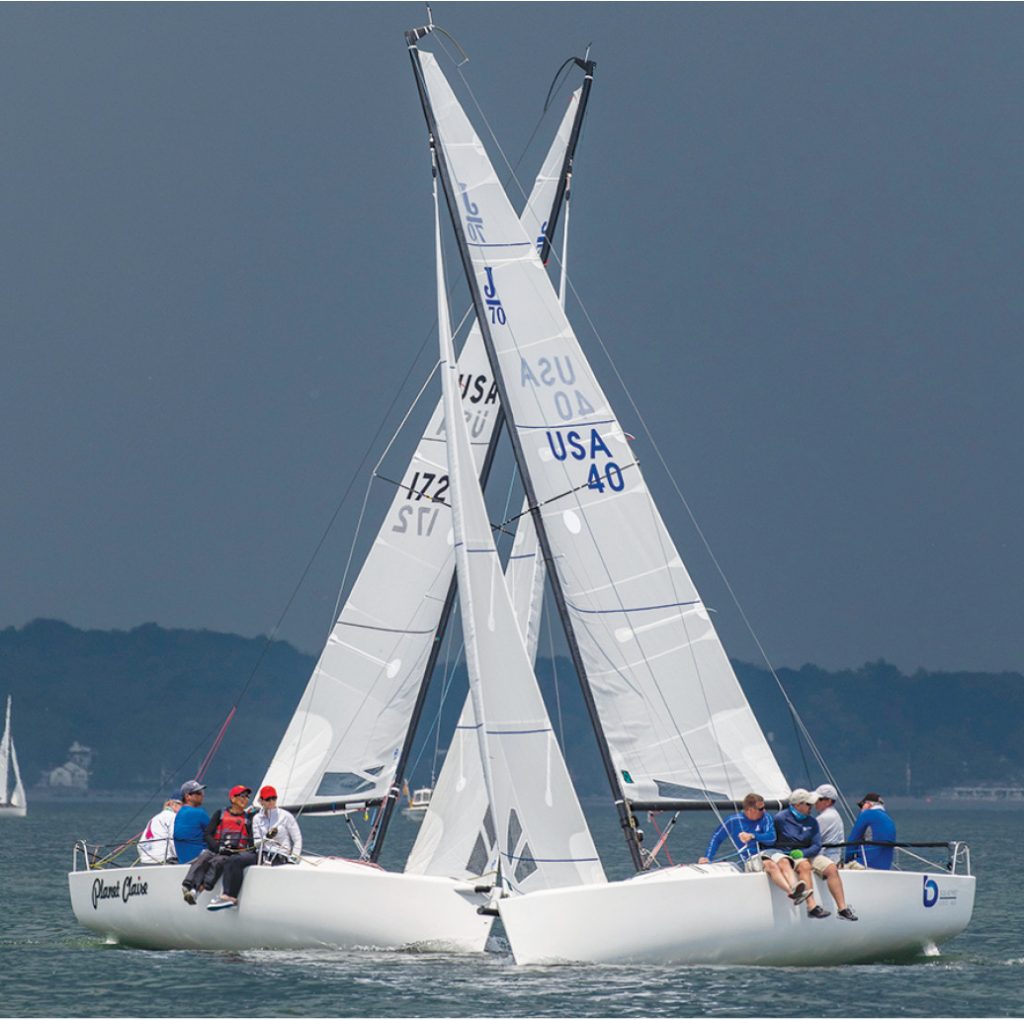By David Dellenbaugh
It’s blowing about 15 knots and you’re racing up the first beat of the first race at the J/24 Nationals. The wind has been oscillating all day, and you are now sailing a lift on port tack, crossing almost all the boats that were to your right.
Your crew is focused on the wind and waves ahead, and everyone is hiking to keep the boat flat.
“Puff coming in 10 seconds,” says your bow person. Your jib trimmer jumps off the rail to get a couple more clicks of trim on the leeward winch before the puff hits. As he reaches the leeward side and looks around the genoa clew, he suddenly freezes.
“Starboard tacker!” he screams. “Tack now!” He releases the sheet. Your helmsperson throws the helm over and everyone scrambles to the new high side. The tack was obviously not very good, and the starboard tacker rolls you within a couple boatlengths. Worse yet, you are now on a starboard tack header, crossing behind the boats still lifted on port tack. Your first beat has been all but ruined.

Each time you cross tacks with another boat, you must make one more decision about whether you want to go left or right. Your choice depends on which boat has the right of way, whether or not the port tacker can tack into a leebow position, and what strategy you are pursuing. When I sail up the first beat, I usually try to keep in mind which side of the course I like at any moment. For example, I might think to myself, “Left, left, left…” This way, when I converge with other boats, it’s easier to do the right thing. © Stephen R Cloutier
What is the moral of this sad story? First of all, keep a good lookout whenever you’re racing upwind. This can be difficult when it’s windy and you have a genoa, but it’s essential to ensure that you have enough time to make good tactical and strategic decisions.
A second lesson is that you must use tactics to follow your strategic gameplan. In this situation, your strategy should have been obvious: It was to keep sailing on the port-tack lift until you got the next header. If other boats threatened your plan, you needed good tactical moves to stick with it as closely as possible. Let’s see how this situation could have developed in the ideal world:
Your crew is focused on the wind and waves ahead, and everyone is hiking to keep the boat flat.
“What’s our strategy now?” asks Betty, your mainsail trimmer.
“I think we should just keep going right, at least until we get headed a lot more,” says the skipper.
“I agree,” says a voice from the windward rail.
“Do we have any other boats to worry about?” asks the skipper.
“Only if that one tacks,” says Betty, looking under the boom and pointing to a boat sailing parallel to us on port tack.
“OK, keep an eye on them.”
“Puff coming in 10 seconds,” says your bow person.
“They’re tacking!” shouts Betty.
“OK, we’re going to duck and keep going right,” says the skipper.
Your jib trimmer jumps off the rail to ease the genoa sheet while Betty gives a big ease on the main. You bear off smoothly behind the starboard tacker and continue sailing on the lift. When the next header comes, you are in great shape. Your first beat is turning out to be quite a success. ■
This article originally appeared in David Dellenbaugh’s Speed & Smarts, The newsletter of how-to tips for racing sailors. If you want to sail faster and smarter, log onto SpeedandSmarts.com.
A resident of Easton, CT, Dellenbaugh was tactician and starting helmsman for America3’s successful defense of the America’s Cup in 1992. He’s a Lightning World Champion, two-time Congressional Cup winner, seven-time Thistle National Champion, two-time winner of the Canada’s Cup, three-time Prince of Wales U.S. Match Racing Champion, and a winner of the U.S. Team Racing Championships for the Hinman Trophy.




